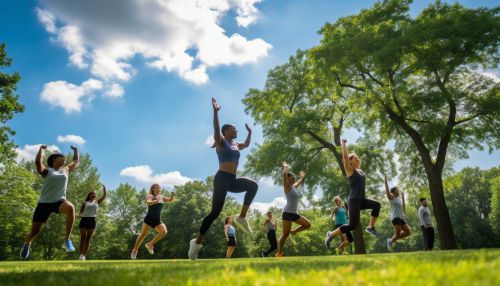Aerobic exercise
Definition and Overview
Aerobic exercise, also known as cardio, is a type of physical activity that primarily uses your large muscle groups, is rhythmic in nature, and can be maintained continuously for extended periods of time. The term "aerobic" means "with oxygen", which refers to the oxygen that is used to produce energy during these exercises. Aerobic exercise stimulates the heart rate and breathing rate to increase in a way that can be sustained for the exercise sessionexercise physiology.
Benefits
Aerobic exercise has numerous health benefits, both physical and mental. It can help prevent or reduce the risk of developing many health problems such as heart disease, diabetes, certain types of cancer, arthritis, and depression. It can also help improve mood, boost energy levels, promote better sleep, and aid in weight management.
Types of Aerobic Exercise
There are many types of aerobic exercise, each with its own benefits and challenges. Some of the most common types include:
- Running: This is a high-impact aerobic exercise that can burn a significant number of calories in a short amount of time. It requires a good level of fitness and can be hard on the joints.
- Swimming: This is a low-impact aerobic exercise that is good for people with joint problems. It can help to improve strength, flexibility, and cardiovascular fitness.
- Cycling: This can be done on a stationary bike or on a regular bike. It is a low-impact exercise that can help to improve leg strength and cardiovascular fitness.
- Walking: This is a low-impact exercise that is suitable for people of all fitness levels. It can help to improve cardiovascular fitness and aid in weight management.
- Aerobics classes: These classes can include a variety of exercises such as step aerobics, dance aerobics, water aerobics, and more. They can help to improve cardiovascular fitness, coordination, and flexibility.
Aerobic Capacity
Aerobic capacity, also known as VO2 max, is the maximum amount of oxygen the body can use during intense exercise. It is a measure of aerobic fitness and can be improved through regular aerobic exercise. The higher your VO2 max, the more oxygen your body can use, and the better your aerobic fitness.
Aerobic vs Anaerobic Exercise
While both aerobic and anaerobic exercise are important for overall fitness, they serve different purposes and have different effects on the body. Aerobic exercise primarily improves cardiovascular fitness and burns fat, while anaerobic exercise, such as weightlifting or sprinting, primarily builds muscle and power.
Safety Considerations
While aerobic exercise is generally safe for most people, it is important to consider certain safety precautions. This includes warming up before starting the exercise, cooling down after the exercise, staying hydrated, wearing appropriate footwear, and listening to your body to avoid overexertion.
Conclusion
Aerobic exercise is a vital part of a balanced fitness regimen. It offers numerous health benefits and can be tailored to fit the needs and abilities of virtually anyone. Whether you prefer running, swimming, cycling, or taking an aerobics class, there is an aerobic exercise out there for you.
See Also
- Exercise Physiology
- Heart Disease
- Diabetes
- Cancer
- Arthritis
- Depression
- Running
- Swimming
- Cycling
- Walking
- Aerobics Classes
- VO2 Max
- Anaerobic Exercise


